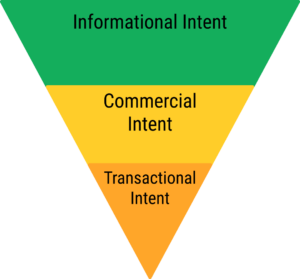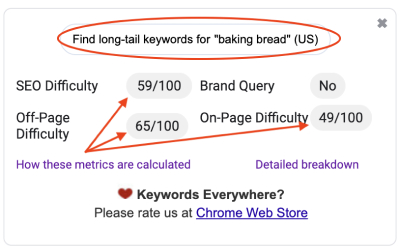Author:
James Hipkin
Publish Date:
January 30, 2024
As a business owner, you already know that having the best product or service isn’t enough. Your audience needs to find you. Back in the day, your retail location was enough. But today’s reality is different.
All businesses need an online presence so that prospective customers can find them. Search Engine Optimization (SEO) is one of the ways that prospects find your business. That’s where keyword research comes in—it’s the yeast that helps your online presence rise. (Sorry, I couldn’t help myself.)
Keyword research is perhaps the easiest and most important SEO task you can use to bring qualified prospects to your website organically. This post draws on my experience and provides a number of tips and techniques, but what makes it a bit different is how I use search intent to map keyword research to the stages in the marketing funnel. The ideas presented here will help you use SEO broadly and keywords more specifically to support your customers’ journey.
Most businesses don’t put any effort into SEO, so you only need to be a bit better than the others to rise above the rest. This is especially true for local search. But before we dive in, it’s not all wine and roses. I want to give you some caveats from my years of practical experience.
SEO – Some Considerations Before You Start
SEO is Hard
While most basic SEO tasks aren’t hard, success requires a significant commitment. If you aren’t ready to make the commitment, SEO should not be your first consideration. It takes a long time and a good deal of consistent effort. You are competing with many other websites that are bigger and better positioned than yours. This said, it is a good idea to understand how SEO works and use SEO best practices whenever you can. This will pay off over time, and keyword research is the place to start.
Don’t Game the System
If you want to use SEO to bring prospects to your website, recognize that you shouldn’t try to game the system. The search engines want to provide searchers with helpful content that satisfies their needs. If you create content for searchers, not for search engines, you are more likely to see success over time.
Serve Your Audience
It’s vital that you understand who you are serving with the content you’ll be creating on your website. It’s not about you; it’s about them and where they are in their journey. You will see that I’ve incorporated this essential idea into the upcoming how-to steps and why I emphasize mapping keyword search intent to the marketing funnel.
SEO is a Long Game
Don’t chase high search volumes. By targeting low-volume and low-competition keywords, you will gradually build traffic. SEO is a long game. The approach I recommend in this post will help you discover low-competition keywords that resonate with your ideal customers. Then, I’ll discuss integrating the selected keywords into your marketing in a way that supports your audience’s journey.
Given the caveats discussed, and assuming I haven’t scared you away, this post will share how I use keyword research to find keywords that bring revenue to my clients’ businesses. With a bit of work, keyword research can help you write social media posts, emails, website pages, and blog posts that will attract qualified traffic to your website.
Let’s get started!
A Keyword Research Strategy for the Rest of Us
Start Broad
Consider the broad keywords your potential customers will use that are relevant to your store or service. Put yourself in their mind and view your business from their perspective. It’s unlikely that you will rank for broad keywords, but these keyword pillars will keep your efforts focused on areas that matter and will be helpful to focus your keyword strategy. More on this later.
Filter by Search Intent
Search intent is a vital and often underappreciated step. Search intent is the glue that lets you integrate keyword research into the entire marketing funnel, not just your website.
OK, so what is search intent?
Great question.
When someone types a keyword into a search engine like Google, ‘Search Intent’ is the reason behind their search. Why are they searching? Where are they on their journey? What are they hoping to find? What’s their intent?
For our purposes, we’ll focus on three search intent buckets. There are more than three, but we’re going to focus on the three that will be most useful for finding keywords that will impact your business:

1. Informational Intent: Here, the searcher is looking for information. For example, “How to bake bread.” They’re not necessarily looking to buy anything at this stage.
You want a lot of these. They align with the top of the marketing funnel—Attention.
2. Commercial Intent: This is the middle area between informational and transactional. The searcher is researching a purchase and is looking for the best option, such as “Best smartphones 2024” or “Top accounting software for small business.”
Keywords with commercial intent align with the marketing funnel’s important and often underappreciated middle: Consideration and Prospecting.
3. Transactional Intent: In this case, the searcher is deep in their journey and wants to buy something. For instance, “Buy noise-canceling headphones online.”
Transaction intent keywords align with the marketing funnel’s bottom section—Action.
Once you understand where search intent aligns with the marketing funnel and which long-tail keywords go into each bucket, it will be easier to determine where to use the keywords in your content. We’ll dig into this more later in this post when discussing competitive analysis, but the bottom line here is, don’t force fit keywords into the wrong content.
Why is Search Intent Important?
Your audience’s search intent is the connective tissue between SEO and the marketing funnel. It helps you craft and place content that supports your prospects where they are in their journey. This builds trust and draws them toward your solution in a natural way.
For example, when the intent is informational, your content needs to align with this intent: a blog post or detailed explanation on a services page. Don’t try to optimize a product listing or transactional content for keywords with an informational intent. Your content won’t get ranked.
Understanding search intent is as much art as it is science. But in the end, don’t guess. The search engines will tell you how they view a keyword query. Do the search and then analyze the top results on the results page. If “ancient grains for baking” is dominated by educational articles, don’t try to force the keyword into a product page. Go with the flow – compete with the competition.
Search Intent Examples
Your content strategy needs to cover a range of intents. For example, keywords with informational intent like, “What is spelt flour?” attract consumers high in the marketing funnel. Content like this builds trust, which leads to loyal customers.

Another example could be a blog post titled “10 Tips for Perfect Sourdough.” Content like this is informational content that will attract your target market. Then, you can subtly promote your flour by linking a related keyword with commercial intent within the blog post to a product you sell in your store. When this is in the context of genuinely helping readers, it’s more effective.
A bit deeper in the funnel, there’s Consideration. Here, you will want to optimize content for commercial intent with keywords like “using organic rye flour” to attract searchers who are deeper in the marketing funnel. For example, recipes are an excellent way to draw searchers to your website at this stage. When they search for a recipe, you know they are actively using the product you are selling.
The next level is Prospecting. Comparison content like “best flours for whole wheat bread” works here. Review posts are also suitable for prospecting keywords. Consider a series of blog posts that objectively present your products in the context of the competition to attract prospects actively searching for options. An effective strategy is to optimize category pages with Commercial keywords that will attract searchers seeking a choice.
The final level is Transaction. An effective strategy here is to optimize product page descriptions with transaction keywords that will attract searchers seeking a solution. Another tactic mentioned above is cross-linking Commercial and Transaction intent keywords to related products in your store.
Keyword Research – Getting Started
Use keyword modifiers to filter keywords based on search intent. The table below shows common keyword modifiers organized into the three search intent areas: Informational, Commercial, and Transactional. You can use the modifiers to filter keywords into search intent buckets. Then, you should confirm the intent by observing the search engine results page (SERP) to see if the search engines agree.

Use this list as a starting point. You know your business; your lists may or may not include all the modifiers shown here. Your list of modifiers will likely include some not shown here. Use our table as a starting point.
Remember, at its core, SEO is about connecting with and supporting your audience where they are in their journey. You do this by aligning your content with consumer search intent. Then, your marketing is more likely to serve your audience, increasing the chances of engaging potential customers, building trust, and driving traffic and sales.
Searchers and, therefore, search engines are looking for helpful content. And ‘helpful’ depends on where the searcher is in their journey, which is why we recommend mapping keywords to the marketing funnel. Content that provides solutions for searchers where they are in their journey is more likely to rank on the SERP. Embracing this simple idea will go a long way to lifting your content above your competition.
What’s Working for Competitors?
Finally, have a look at what’s working for others. If a rival mill is gaining traction with “rye flour recipes,” use this as yeast for your content.
Assessing the competition also helps you avoid swimming upstream. If all the sites ranking on the first page have domain authority above fifty out of one hundred, your website will be swimming against the current.
And finally, remember that step one is to create value for customers where they are in their journey – every keyword should solve their problems or answer their questions where they are. You want to use SEO to bring value to your customers and deliver revenue to your business.
Now, let’s get your hands floury.
Effective Keyword Research for the Rest of Us
The following section will outline the five steps to developing a keyword strategy that will attract and build relationships with your best customers.
I will be using Keywords Everywhere for this example. Keywords Everywhere is a low-cost, effective tool that will take you a long way. For an in-depth explanation of Keywords Everywhere, read our post, “Mastering Content Writing with Keywords Everywhere.”
Tools like Semrush and ahref go deeper, at greater cost, but Keywords Everywhere will be more than enough to get you started.
Step One: Start Broad

You won’t rank for these terms. Their purpose is to provide pillars for your keyword strategy.
In this example, we will use ‘baking bread.’ This keyword has over twelve thousand searches and a significant keyword difficulty score—0.9. The goal isn’t to rank for this keyword but to use it as a pillar in your keyword strategy. A completed keyword strategy will have several pillars like this. You can also use pillar keywords as content categories in your website. These category pages organize content around specific themes—the keyword pillars. You use categories for blog posts and products in an online store. They are an excellent and often underutilized SEO technique that’s especially effective for content and e-commerce websites.
Step Two: Find Related Long-Tail Keywords

The initial list will likely be huge. In this case, Keywords Everywhere identified 811 long-tail keywords for this pillar. You should have multiple pillars.
One thing to note is that the Keywords Everywhere report pulls data from Google Ad Planner, so the competition scores reflect the difficulty of buying ads using the keyword. While not the same, in the early stages of your research, you can use the competition score as a surrogate for organic search difficulty. It’s a score where 1.0 is the most competitive score.
You can filter the results within the Keywords Everywhere dashboard or export the data and work with it using a spreadsheet. I prefer to do data manipulation within a spreadsheet.

We are happy to share the Google Sheets template with you.
Use the button below to provide your name and email, and we’ll send you the link.
Step Three: Filter for Search Intent
Use the modifiers introduced above to filter the list for search intent and build a list of keywords for each bucket. Don’t worry about volume or competition at this point.
It’s also essential to scan the master list, looking for keywords not identified using the modifier shortcut. There will be a bunch. Make your best guess and assess each for search intent. Then, place them in the appropriate bucket. You will confirm your choice in Step Four.
Here’s a short video that shows you how to use filters in Google Sheets.
Step Four: Cleanup, Confirm Search Intent and Assess Potential
Now that you’ve populated the three keyword groups with choices, it’s time for some cleanup. Scan through and remove keywords that aren’t applicable. For example, you can remove a keyword like “is baking bread cheaper than buying it uk” or adjust it to say “us” rather than “uk” and see if there’s an opportunity to use this long-tail keyword. Another example would be “baking breaded pork chops.” Ranking for this won’t be useful.
Once you’ve completed some cleanup, it’s time to confirm that the keywords are in the correct buckets. I’m sorry to say that this is a bit tedious. Start with the ones with reported search volume. Take each keyword and do a search. Then, analyze the SERP to see if Google’s assignment of search intent aligns with your decision. Don’t argue with the Google. Move things around as appropriate.
Next up, you will want to consider each keyword’s potential. Look at the reported volume. Don’t be put off by a zero. Remember, the data comes from Google’s Ad Planner platform. Zero says Google ad campaigns aren’t using the term, but it doesn’t mean there aren’t any searches for the term. When you analyze each potential long-tail keyword competitively, you will see that there is search volume.
Step Five: Review the Content That’s Working and Assess Keyword Difficulty
Step five is perhaps the most critical step in all of this. For likely candidates, review what’s on page one of the SERP for each. Some questions to ask:
- What’s the domain authority of the top-ranked sites? The Keywords Everywhere extension inserts Moz DA and estimated volume for each link.
- What’s the estimated traffic volume for each keyword? (take this with a grain of salt.)
- How are the top-ranked articles built? Are the articles short or long? How long? How many images? How many titles? What’s the writing style? What do you think is missing?
If you are competing with monster websites with high domain authority (>50) and thousands of backlinks, your content might have a chance, miracles do happen, but your chances are slim. Don’t tilt at windmills. Look for keywords with lower competition. You are better off building traffic with lots of small wins.
Keyword Research – The Cooling Rack
And there you have it, your freshly baked guide to keyword research.
- Start broad; pick keyword pillars that support your customer’s journey.
- Find long-tail keywords related to each pillar keyword.
- Use search intent modifiers to place long-tail keywords into corresponding areas of the marketing funnel.
- Clean up your list and confirm that the search engines agree with your assessment of search intent.
- Further, refine your list by considering the pages you will compete with for domain authority and style.
At the end of this process, you will have a manageable list of keywords aligned to specific areas of the marketing funnel that you can incorporate into content marketing.
As I mentioned, SEO shouldn’t be your first or only channel to drive traffic to your website. Developing an SEO keyword strategy is a lot of effort, but if you choose to invest in SEO, it’s not something you need to do every time you create content. And it’s an investment that will pay off over time. Once your keyword strategy is in place, it will support your efforts for many months. We recommend that you monitor what’s working and make updates periodically. Once a quarter is ideal.
Remember, it’s all about understanding what makes your customers’ bread rise – metaphorically speaking. This post is by no means an exhaustive tutorial. The SEO rabbit hole is deep and has many tunnels. The intent here is to get you started in a practical way. Since most don’t do anything with SEO, even a limited investment in keyword research will give you a leg up on the competition. Do the work, and your efforts will have a positive impact. Now, go forth and sprinkle these SEO grains wisely!
How Website Taxonomy Can Improve Your Organic Traffic and Your Sales
How to use taxonomy to improve page rank and increase high-quality traffic.
How to Write Blog Content That Ranks (and Resonate Better with Readers)
Content that’s useful to readers is more likely to rank. Easy to say and understand, but much harder to do. We have some ideas that work for us.
A Keyword Research Step-by-Step Guide for the Rest of Us
Keyword research helps you select keywords that attract quality traffic to your website. In this article, we provide a how-to guide to effective keyword research.
Author: James Hipkin
Since 2010, James Hipkin has built his clients’ businesses with digital marketing. Today, James is passionate about websites and helping the rest of us understand online marketing. His customers value his jargon-free, common-sense approach. “James explains the ins and outs of digital marketing in ways that make sense.”
Use this link to book a meeting time with James.

